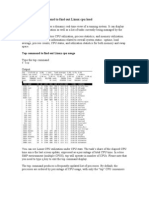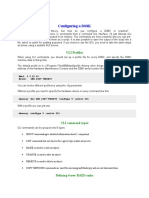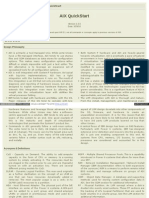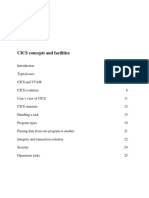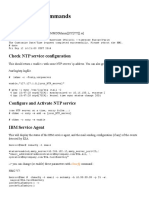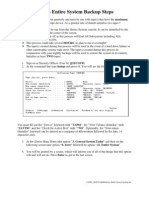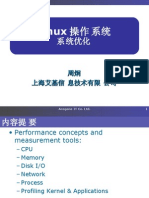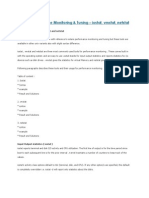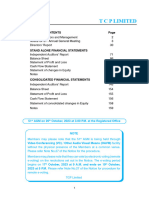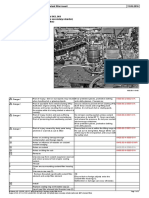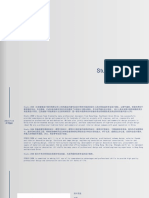Welcome to:
Performance and Workload Management
Copyright IBM Corporation 2004 Course materials may not be reproduced in whole or in part without the prior written permission of IBM.
3.0.2
�Unit Objectives
After completing this unit, students should be able to: Provide basic performance concepts Provide basic performance analysis Manage the workload on a system Work with the Performance Diagnostic Tool (PDT)
Copyright IBM Corporation 2004
�Performance Problems
What a fast machine!
The system is so slow today!
Performance is very often not objective!
Copyright IBM Corporation 2004
�Understand the Workload
Analyze the hardware: Model Memory Disks Network Identify all the work performed by the system Identify critical applications and processes: What is the system doing? What happens under the cover (for example, NFS-mounts)? Characterize the workload: Workstation Multiuser System Server Mixture of all above?
Copyright IBM Corporation 2004
�Critical Resources: The Four Bottlenecks
CPU
Memory
Disk I/O
Network
Number of processes Process-Priorities
Real memory Paging Memory leaks
Disk balancing Types of disks LVM policies
NFS used to load applications Network type Network traffic
Copyright IBM Corporation 2004
�Identify CPU-Intensive Programs: ps aux
# ps aux USER PID root 516 johnp 7570 root 1032 root 1
%CPU 98.2 1.2 0.8 0.1
%MEM 0.0 1.0 0.0 1.0
... ... ... ... ...
STIME 13:00:00 17:48:32 15:13:47 15:13:50
TIME 1329:38 0:01 78:37 13:59
COMMAND wait -ksh kproc /etc/init
Percentage of time the process has used the CPU
Percentage of real memory
Total Execution Time
Copyright IBM Corporation 2004
�Identify High-Priority Processes: ps -elf
# ps -elf F S 200003 A 240001 A 200001 A
UID PID PPID C PRI 0 1 0 0 60 0 3860 1 0 60 299 7852 7570 24 72
NI 20 20 20
... ... ... ...
TIME CMD 13.59 init 6:06 syncd 0:00 ps
Priority of the process
Nice value
The smaller the PRI value, the higher the priority of the process. The average process runs a priority around 60. The NI value is used to adjust the process priority. The higher the nice value is, the lower the priority of the process.
Copyright IBM Corporation 2004
�Basic Performance Analysis
Check CPU
sar -u
possible CPU constraint
yes
High CPU % no Check memory
vmstat
no
iostat
Check disk
High paging yes
Balance disk possible memory constraint
no
Disk balanced yes possible disk/SCSI constraint
Copyright IBM Corporation 2004
�Monitoring CPU Usage: sar -u
Interval Number
# sar -u 60 30 AIX www 08:25:10 48 08:26:10 63 08:27:10 59 . . Average 57 43 0 0 1 5 000400B24C00 06/06/01 %wio 0 0 0 0 0 0 %idle 52 37 41 08:24:10 %usr %sys
A system is CPU bound, if: %usr + %sys > 80%
Copyright IBM Corporation 2004
�Simultaneous Multi-Threading (SMT)
Each chip appears as a two-way SMP to software Appear as 2 logical CPUs Performance tools may show number of logical CPUs Processor resources optimized for enhanced SMT performance May result in a 25-40% boost and even more. Benefits vary - based on workload To enable: smtctl [ -m off | on [ -w boot | now]]
Copyright IBM Corporation 2004
�Monitoring Memory Usage: vmstat
Summary report every 5 seconds
# vmstat 5 kthr ---r 0 0 0 0 0 b memory page ... cpu ----------- ---------------------------------------avm fre 81 66 69 64 5821 re 0 0 0 0 0 pi 0 0 0 21 24 po 0 16 53 0 0 fr sr cy 0 0 0 0 0 ... us 1 1 1 20 5 sy 2 6 4 5 8 id 95 77 63 42 41 wa 2 16 33 33 46
0 8793 0 9192 0 9693 0 10194 0 4794
1 7 81 167 95 216 0 0 0 0
pi, po: Paging space page ins and outs: If any paging-space I/O is taking place, the workload is approaching the system's memory limit wa: I/O wait percentage of CPU If nonzero, a significant amount of time is being spent waiting on file I/O
Copyright IBM Corporation 2004
�Monitoring Disk I/O: iostat
# iostat 10 2
tty: tin 0.0 tout avg-cpu: %user %sys 4.3 0.2 0.6 Kbps 0.2 0.0 0.0 tps 0.0 0.0 0.0 Kb_read 7993 0 0 %idle %iowait 98.8 0.4 Kb_wrtn 4408 0 0 %idle %iowait 0.0 33.7 Kb_wrtn 8 0 0
cumulative activity since last reboot
Disks: %tm_act hdisk0 hdisk1 cd0 tty: tin 0.1 0.0 0.0 0.0
tout avg-cpu: %user %sys 110.7 7.0 59.4 Kbps 115.7 0.0 0.0 tps 28.7 0.0 0.0 Kb_read 456 0 0
Disks: %tm_act hdisk0 hdisk1 cd0 77.9 0.0 0.0
A system is I/O bound, if: %iowait > 25%, %tm_act > 70%
Copyright IBM Corporation 2004
�topas
CPU Info
iostat Info
VMSTAT Info
Copyright IBM Corporation 2004
�topas, vmstat, and iostat Enhancements for Micro-Partitioning (AIX 5.3)
Added two new values to the default screen Physc and %Entc The vmstat command has two new metrics: pc and ec The iostat command has also two new metrics: %physc and %entc
Copyright IBM Corporation 2003
�AIX Performance Tools
Identify causes of bottlenecks:
CPU Bottlenecks Processes using CPU time
tprof
c
Memory Bottlenecks Processes using memory
AUS
es
svmon
I/O Bottlenecks File systems, LVs, and files causing disk activity
filemon
Copyright IBM Corporation 2004
�AIX Tools: tprof
# tprof -x sleep 60 # more _prof.all
Process wait netscape_aix4 lslpp Process wait netscape_aix4 ksh PID 516 23494 17566 FREQ 1 5 46 TID 517 40015 43613 Total 6855 961 77
This file is created by tprof
Total 6855 201 11 Kernel 6855 122 64
Kernel 6855 27 5 User 0 139 7
User 0 29 4 Shared 0 700 6
Shared 0 145 2 Other 0 0 0
Other 0 0 0
Copyright IBM Corporation 2004
�AIX Tools: svmon
Global report # svmon -G
memory pg space size inuse 32744 20478 65536 294 work 2768 13724 pers 0 6754 free 12266 pin virtual 2760 11841
pin in use
clnt 0 0
Sizes are in # of 4K frames
# svmon -Pt 3
Pid 14624 9292 3596 Command java httpd X
Top 3 users of memory
Inuse 6739 6307 6035 Pin 1147 1154 1147 Pgsp 425 205 1069 Virtual 4288 3585 4252 64-bit N N N Mthrd Y Y N
* output has been modified
Copyright IBM Corporation 2004
�AIX Tools: filemon
# filemon -o fmout Starts monitoring disk activity
# trcstop # more fmout
Stops monitoring and creates report
Most Active Logical Volumes
util 0.03 0.02 0.02 #rblk 3368 0 56 #wblk 888 1584 928 KB/s 26.5 9.9 6.1 volume /dev/hd2 /dev/hd8 /dev/hd4 description /usr jfslog /
Most Active Physical Volumes
util 0.10 0.02 #rblk 24611 56 #wblk 12506 8418 KB/s 231.4 52.8 volume /dev/hdisk0 /dev/hdisk1 description N/A N/A
Copyright IBM Corporation 2004
�There Is Always a Next Bottleneck!
Our system is I/O bound. Let's buy faster disks !
# iostat 10 60
Our system is now memory bound! Let's buy more memory !!! # vmstat 5 Oh no! The CPU is completely overloaded !
# sar -u 60 60
Copyright IBM Corporation 2004
�Workload Management Techniques (1 of 3)
Run programs at a specific time
# echo "/usr/local/bin/report" | at 0300 # echo "/usr/bin/cleanup" | at 1100 friday
# crontab -e 0 3 * * 1-5 /usr/local/bin/report
minute
hour day_of_month month
weekday
command
Copyright IBM Corporation 2004
�Workload Management Techniques (2 of 3)
Sequential execution of programs
# vi /etc/qconfig ksh: device = kshdev discipline = fcfs kshdev: backend = /usr/bin/ksh # qadm -D ksh # qprt -P ksh report1 # qprt -P ksh report2 # qprt -P ksh report3 # qadm -U ksh
Queue is down Jobs will be queued Queue is up: Jobs will be executed sequentially
Copyright IBM Corporation 2004
�Workload Management Techniques (3 of 3)
Run programs at a reduced priority
# nice -n 15 backup_all & # ps -el F S UID PID PPID C PRI 240001 A 0 3860 2820 30 90
NI
...
TIME 0:01
CMD backup_all
35 ...
Very low priority
Nice value: 20+15
# renice -n -10 3860 # ps -el F S UID PID PPID 240001 A
C PRI 78
NI
...
TIME 0:02
CMD backup_all
0 3860 2820 26
25 ...
Copyright IBM Corporation 2004
�Next Step
Exercise 11: System Performance
Copyright IBM Corporation 2004
�Performance Diagnostic Tool (PDT)
PDT assesses the current state of a system and tracks changes in workload and performance.
Balanced use of resources
Operation within bounds
Identify workload trends
PDT
Error-Free Operation
Changes should be investigated
Appropriate setting of system parameters
Copyright IBM Corporation 2004
�Enabling PDT
# /usr/sbin/perf/diag_tool/pdt_config
-----------PDT customization menu----------1) show current 3) disable 5) disable 6) de-install 7) exit pdt_config Please enter a number: 4 PDT report recipient and severity level PDT reporting PDT collection PDT 2) modify/enablePDT reporting 4) modify/enable PDT collection
Copyright IBM Corporation 2004
�cron Control of PDT Components
# cat /var/spool/cron/crontabs/adm 0 9 * * 1-5 /usr/sbin/perf/diag_tool/Driver_daily
Collect system data, each workday at 9:00
0 10
1-5
/usr/sbin/perf/diag_tool/Driver_daily2
Create a report, each workday at 10:00
0 21 * * 6 /usr/sbin/perf/diag_tool/Driver_offweekly
Cleanup old data, each saturday evening
Copyright IBM Corporation 2004
�PDT Files
Collection Driver_ daily /var/perf/cfg/diag_tool/.collection.control
Clean Up Driver_ offweekly /var/perf/cfg/diag_tool/.retention.control 35 days .retention.list
Reporting
/var/perf/tmp/.sm /var/perf/tmp/.SM.discards
Driver_ daily2 /var/perf/cfg/diag_tool/.reporting.control
/var/perf/tmp/.SM.last adm /var/perf/tmp/PDT_REPORT Next Day /var/perf/tmp/PDT_REPORT.last
Copyright IBM Corporation 2004
�Customizing PDT: Changing Thresholds
# vi /var/perf/cfg/diag_tool/.thresholds
(int) (int) (int) ... DISK_STORAGE_BALANCE 800 NUMBER_OF_BALANCE 1 FS_UTIL_LIMIT 90 [0:10000 MB] [0:10000] [0:100%]
Current Value
Valid Range
Copyright IBM Corporation 2004
�Customizing PDT: Specific Monitors
# vi /var/perf/cfg/diag_tool/.files /var/adm/wtmp /var/spool/qdaemon/ /var/adm/ras/ /tmp/
Files and directories to monitor
# vi /var/perf/cfg/diag_tool/.nodes pluto neptun mars
Machines to monitor
Copyright IBM Corporation 2004
�PDT Report Example (Part 1)
Performance Diagnostic Facility 1.0 Report printed: Wed Jun 6 14:37:07 2001 Host name: master Range of analysis included measurements from: Hour 14 on Monday 4th June 2001 to: Hour 9 on Wednesday 6th June Alerts I/O CONFIGURATION - Note: volume hdisk2 has 480 MB available for allocation while volume hdisk1 has 0 MB available PAGING CONFIGURATION - Physical Volume hdisk1 (type:SCSI) has no paging space defined I/O BALANCE - Physical volume hdisk0 is significantly busier than others volume hdisk0, mean util. = 11.75 volume hdisk1, mean util. = 0.00 NETWORK - Host sys1 appears to be unreachable
Copyright IBM Corporation 2004
�PDT Report Example (Part 2)
Upward Trends FILES - File (or directory) /var/adm/ras/ SIZE is increasing now, 364 KB and increasing an avg. of 5282 bytes/day FILE SYSTEMS - File system lv01(/fs3) is growing now, 29.00% full, and growing an avg. of 0.30%/day At this rate lv01 will be full in about 45 days ERRORS - Hardware ERRORS; time to next error is 0.982 days System Health SYSTEM HEALTH - Current process state breakdown: 2.10 [0.5%]: waiting for the CPU 89.30 [22.4%]: sleeping 306.60 [77.0%]: zombie 398.00 = TOTAL Summary This is a severity level 1 report No further details available at severity level >1
Copyright IBM Corporation 2004
�Next Step
Exercise 12: PDT
Copyright IBM Corporation 2004
�Checkpoint
1. What command can be executed to identify CPU-intensive programs?
2. What command can be executed to start processes with a lower priority?
3. What command can you use to check paging I/O?
4. T/F: The higher the PRI value, the higher the priority of a process.
Copyright IBM Corporation 2004
�Unit Summary
The following commands can be used to identify potential bottlenecks in the system: ps sar vmstat iostat If you cannot fix a performance problem, manage your workload through other means (at, crontab, nice, renice). Use PDT to assess and control your systems performance.
Copyright IBM Corporation 2004

